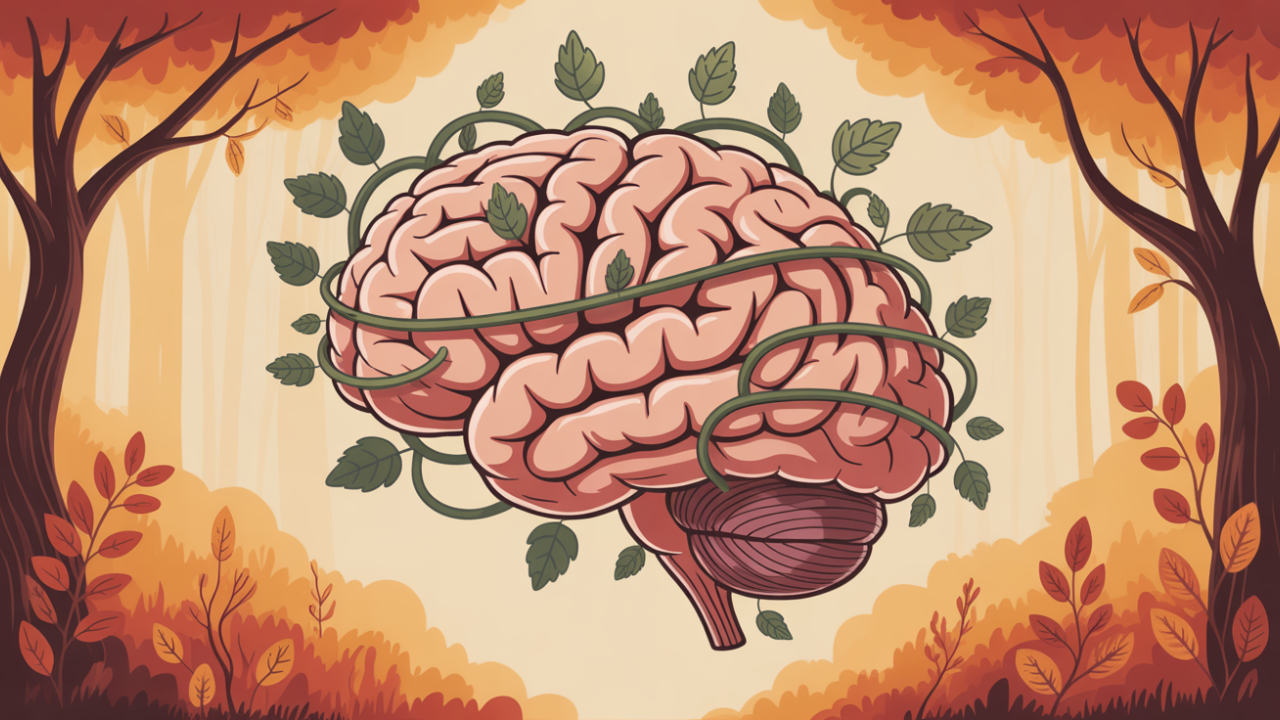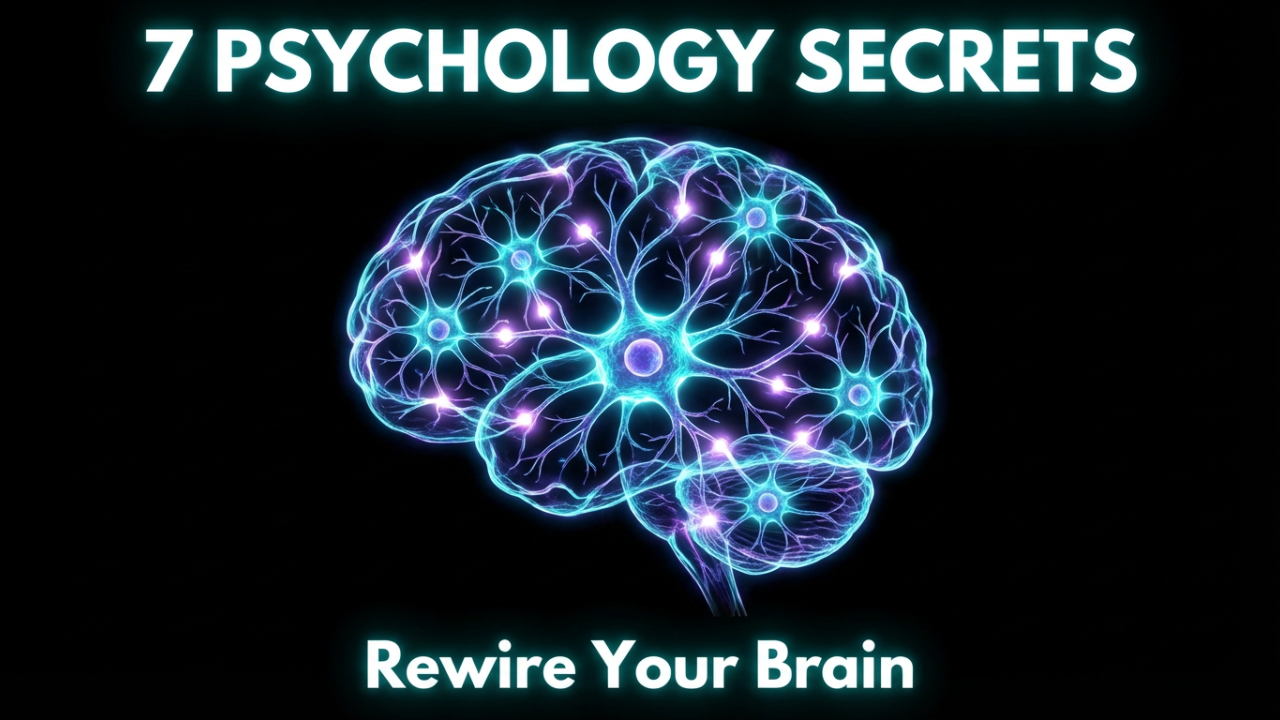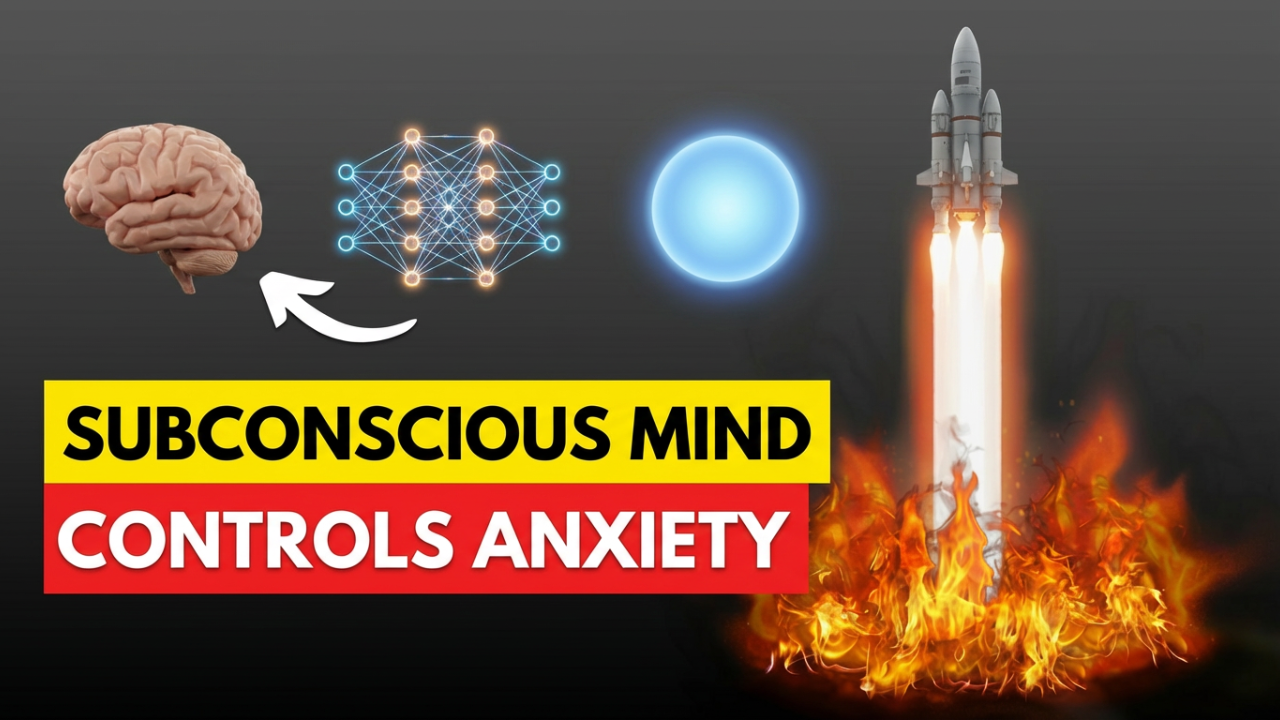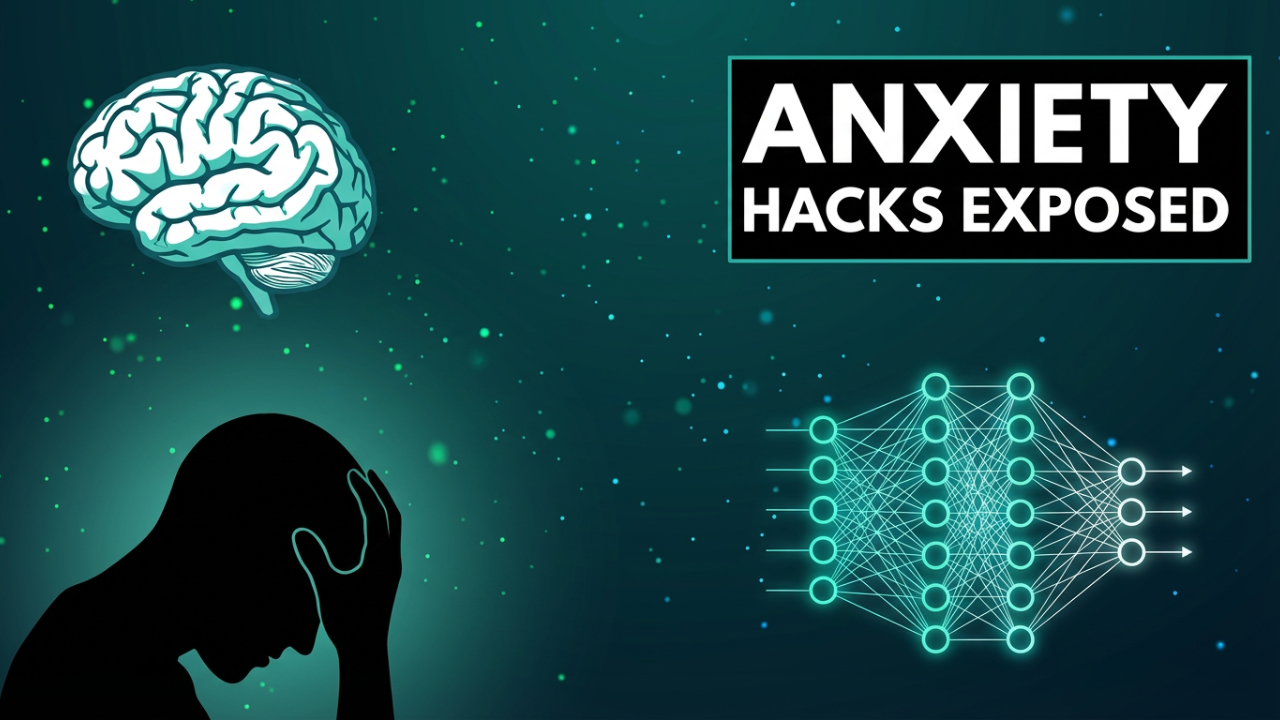You know that constant knot of worry in your stomach. The racing thoughts that insist the worst is about to happen, looping over and over. You feel trapped by it, and maybe a part of you has even started to believe this is just who you are. You’ve tried fighting it, you’ve tried ignoring it, but it feels like you’re serving a life sentence of anxiety that you just have to get through.
But what if that isn’t true? What if the very thing that makes you feel so trapped is actually the key to your freedom? What if science has shown, without a doubt, that you can physically change your brain’s structure and wiring?
In this article , I’m going to show you simple, science-backed exercises that can offer you real calm, right when you need it. More importantly, I’ll show you how to use these exercises to start rewiring your brain for long-term freedom from anxiety. This isn’t about just coping anymore. This is about changing the very way your brain responds to stress. Stick with me, because you’re about to discover a power you didn’t know you had.
This book is scientific documentary of the Kingdom of God.
**(Section 1: The Science Made Simple – Why You Feel Stuck and How You Get Unstuck)**
Before we jump into the exercises, it’s critical to understand *why* you feel the way you do. Because once you get the mechanism, you’ll see that anxiety isn’t a personal failing or a permanent part of your personality. It’s a pattern. And any pattern that can be learned, can be unlearned.
The reason you have this power is a concept called **Neuroplasticity**.
For a long time, scientists thought the adult brain was like concrete; once you hit a certain age, it was set in stone. But we now know the brain is more like clay, capable of being reshaped and remolded your entire life. Neuroplasticity is simply the brain’s ability to reorganize itself by forming new connections. Think of it like this: your thoughts are like footsteps in a dense forest. The first time you have an anxious thought, it’s like hacking a new path—it’s tough. But if you keep walking that same path, the brush gets cleared, a trail forms, and it becomes easier and easier to follow. Before you know it, that path is a deep, well-worn groove. It’s the default route.
Your anxiety works the same way. It’s not a “thing” you have; it’s a pathway your brain has learned to take. We call this the “Anxiety Cycle.” It looks like this:
First, there’s a **Trigger**. This can be anything—a work email, a social event, even a random thought.
Second, that trigger leads to an **Anxious Thought**. Your brain, trying to protect you, jumps to a worst-case scenario. “My boss is mad at me.” “Everyone is going to think I’m awkward.” “What if something awful happens?”
Third, this thought causes a **Physical Sensation**. Your brain’s alarm center, a small almond-shaped region called the **amygdala**, kicks into overdrive. It floods your body with stress hormones like adrenaline and cortisol. This is your fight-or-flight response. Your heart pounds, your chest gets tight, you feel dizzy.
Fourth, you have a **Behavioral Response**. Because these feelings are so awful, your natural instinct is to make them go away. Usually, this means avoidance. You don’t reply to the email. You cancel plans. You try to distract yourself.
And here’s the most important step: **Reinforcement**. When you avoid the trigger, you get a moment of relief. The anxiety goes down. And your brain learns a powerful, but wrong, lesson: “That thing was dangerous, and avoiding it kept me safe.” The avoidance reinforces the fear. Your amygdala, that overprotective alarm system, gets a gold star. It thinks, “See? I was right to sound the alarm! I’ll be even quicker next time.”
Meanwhile, another part of your brain, the **prefrontal cortex**, is supposed to be the CEO. It’s your center for logic and reason. Its job is to look at the situation and say, “Hey amygdala, take it easy. It’s just an email, not a saber-toothed tiger.” But in a chronically anxious brain, the connection between the calm, rational prefrontal cortex and the hyper-reactive amygdala is weak. The amygdala is screaming, and the prefrontal cortex can’t get a word in.
This is the loop that keeps you stuck. It’s a well-worn neural path.
But the beautiful, hopeful truth of neuroplasticity is that you are not stuck with these pathways. You can let the old, anxious trails become overgrown and unused. And you can start forging new, calm ones. The exercises we’re about to cover are the tools you’ll use to do exactly that. Every time you consciously choose a different response, you are physically rewiring your mind. You’re weakening the power of the amygdala and strengthening the influence of your prefrontal cortex.
The goal isn’t to never feel anxiety again. It’s a normal human emotion designed to keep us safe. The goal is to teach your brain the difference between a real threat and a perceived one, to turn down the volume on the false alarms, and to get your sense of control back.
So, let’s get started. Let’s begin with the tools for immediate relief, the ones you can use the very next time you feel that wave of anxiety start to rise.
**(Section 2: Immediate Relief Exercises – Tools for Fast Calm)**
When you’re in the grip of anxiety, your body is in a state of alarm. Your sympathetic nervous system—your “fight-or-flight” system—is running the show. For immediate relief, we need to manually turn on the “rest-and-digest” system, the parasympathetic nervous system. These first exercises are your emergency brakes.
**Exercise 1: The Physiological Sigh – Your Built-In Reset Button**
This is not just “taking a deep breath.” This is a specific breathing pattern studied by neuroscientists, shown to be one of the fastest ways to calm your nervous system. It works by quickly offloading excess carbon dioxide from your lungs, which signals to your brain and body that it’s time to relax.
Here’s how you do it. It’s very simple.
Take a deep inhale through your nose. Then, when you feel like your lungs are full, take another short, sharp inhale right on top of it. Then, a long, slow, complete exhale through your mouth.
Let’s do it together.
A deep inhale through the nose… now a second, shorter inhale… and a long, slow exhale through your mouth until you’re empty.
One more time. Deep inhale… another little sip of air… and a long, slow exhale out.
What you’re doing is reinflating the tiny sacs in your lungs, called alveoli, that can collapse under stress. That second inhale pops them back open, allowing for a much more efficient exchange of gas. The long exhale then triggers your parasympathetic nervous system, telling your heart rate to slow down.
You can do this anywhere, anytime. In a meeting, in your car, right in the middle of a difficult conversation. Just one or two physiological sighs can stop that runaway train of anxiety. This is your first tool—a direct line to your own body. Practice it now, when you’re calm, so it becomes automatic when you need it most.
**Exercise 2: Focused Attention & “Name It to Tame It”**
Anxiety loves a scattered, future-focused mind. It yanks your attention into a spiral of “what ifs.” To break this cycle, you have to anchor your attention firmly in the present. Being told to “just be present” can feel impossible when you’re anxious, so we’ll use a more structured approach.
First, **Focused Attention**. This means deliberately placing your focus on a single, neutral thing you can sense.
Right now, just feel the weight of your body on your chair. Notice the points of contact. Feel the pressure. Or, focus on a sound in the room—a humming computer, a clock ticking. Don’t judge it, just listen to it as pure sound. Another powerful anchor is touch. Place your hand on the table. Feel the texture. Is it smooth? Cool? Pick one sensation and pour your attention into it for 30 seconds.
This starves the anxious thoughts of the one thing they need to survive: your attention. You’re telling your brain, “Nope, we are not going down that rabbit hole. We are staying right here.” This simple act helps disengage the looping thoughts and brings your prefrontal cortex, the “CEO,” back online.
Now, let’s add the second layer: **”Name It to Tame It.”**
This powerful technique, from neuroscientist Dr. Dan Siegel, involves simply putting a label on what you’re experiencing. Studies show that the act of naming an emotion can dampen the response in the amygdala.
As you feel anxiety rising, just say to yourself, silently or out loud: “This is anxiety.” Or “I am noticing worry in my chest.” Or “That is an anxious thought.”
By naming it, you create space between you and the experience. You are no longer “I AM anxious,” completely fused with the feeling. You are “I am *observing* anxiety.” You become the observer, not the victim. This engages your prefrontal cortex, the part of your brain that can analyze and reflect, rather than just react.
So, the full exercise is this: Next time you feel anxiety, first, do a physiological sigh. Second, focus your attention on a neutral sensation in the present. Third, name what you’re feeling. “I’m noticing anxiety. I’m feeling it in my stomach. And I’m focusing on my feet on the floor.”
This three-step combo is an incredibly effective intervention. It calms your body, grounds your mind, and shifts you from reacting to observing.
**Exercise 3: Positive Visualization – Rehearsing a Different Reality**
Your brain can’t always tell the difference between something you vividly imagine and something that’s really happening. This is why worrying feels so real—you are literally making your mind and body rehearse for disaster. We can flip this on its head. We can use this same power to rehearse safety, calm, and success.
This isn’t about ignoring problems. It’s about intentionally creating and strengthening neural pathways for positive feelings, giving your brain an alternate route to take.
Here’s a simple visualization you can do right now.
Close your eyes, or just lower your gaze. Take one physiological sigh—a deep breath in, another sip of air, and a long, slow exhale.
Now, imagine a place where you feel completely safe and at peace. It could be a real place—a beach you love, a quiet room, a forest path. Or it could be completely imaginary.
What do you see there? Notice the colors, the light, the shapes.
What do you hear? Waves? Rustling leaves? Or just peaceful silence?
What do you feel? The warmth of the sun on your skin? A cool breeze?
What do you smell? Pine trees? Salt in the air?
Spend a full minute just immersing yourself in the sensory details of this safe place. As you do, notice what happens in your body. Notice the tension in your shoulders letting go. Notice your breathing getting a little slower and deeper.
You are activating the neural networks for calm and safety. You’re giving your brain a reference point for what “safe” feels like, not just as an idea, but as a physical experience. Practicing this regularly has been shown to decrease activity in the amygdala.
You can also use this for specific situations. If you’re anxious about a presentation, spend five minutes each day vividly imagining it going well. See yourself speaking calmly. See the audience engaged. Feel the sense of accomplishment. You are literally building the neural pathway for success before you even walk in the room.
**Exercise 4: Novel Body Movement – Breaking the Freeze Response**
When anxiety hits, we often freeze. We get stuck in our heads, and our bodies get tense and rigid. One of the quickest ways to short-circuit this mental loop is to do something physical, and ideally, something new or unexpected.
Movement does two things. First, it releases a cocktail of helpful neurochemicals like endorphins and dopamine that give you an immediate mood boost. Second, doing a *novel* or unfamiliar movement forces your brain to create new connections, diverting resources away from anxious thoughts.
You don’t need to go for a five-mile run. This is about a quick, in-the-moment pattern interrupt.
Here are some ideas:
* If you’re at your desk feeling anxious, stand up and do 10 jumping jacks.
* Put on your favorite song and dance like a fool for two minutes.
* Try balancing on one foot for 30 seconds, then switch.
* Walk backward down a hallway.
* Try juggling (or pretending to) with a couple of pens.
The key is that the movement requires a bit of focus. It pulls you out of your head and into your body. As neuroscientist Dr. Wendy Suzuki has shown, even a short session of creative movement can significantly decrease reported anxiety levels.
So, next time you feel stuck in a worry loop, don’t just sit there and fight it in your mind. Change your physical state. Move your body in a way it doesn’t expect. It’s a powerful and fast way to signal to your brain that the threat is over and it’s safe to move again.
**(Section 3: Long-Term Rewiring Strategies – Building a Resilient Brain)**
The immediate relief exercises are your life raft. But we don’t just want to survive the storms; we want to build a stronger ship. The following strategies are your daily or weekly practices. They are the slow, steady work that carves new, resilient neural pathways that will, over time, become your brain’s new normal. This is how you fundamentally reduce anxiety’s power in your life.
**Strategy 1: Cognitive Reframing – Becoming the Editor of Your Thoughts**
This is the heart of Cognitive Behavioral Therapy (CBT), one of the most effective treatments for anxiety. It’s built on a simple idea: it’s not an event that causes our anxiety, but our *interpretation* of that event. Anxious brains tend to interpret neutral events in the most negative way possible. Cognitive reframing is the process of catching, challenging, and changing these unhelpful thought patterns.
It’s a three-step process: Catch it, Check it, Change it.
**Step 1: Catch It.** You have to notice your automatic negative thoughts. A great way to do this is with a “thought journal.” For one week, anytime you feel anxious, write down the situation and the exact thought that went through your head.
* *Situation:* Boss sends a one-line email: “Can we talk this afternoon?”
* *Automatic Thought:* “I’m in trouble. She’s going to fire me. I messed something up.”
**Step 2: Check It.** Now, become a detective. Look for the evidence. Challenge the thought, not with fake positivity, but with real curiosity. Ask yourself:
* *What’s the evidence this thought is true?* (Maybe she seemed stressed yesterday.)
* *What’s the evidence this thought is NOT true?* (My last performance review was great. My projects are on time. She was friendly this morning.)
* *What’s another possible explanation?* (She could want to discuss a new project. She might need my help with something. Maybe it’s a team announcement.)
* *What’s the worst that could happen, and could I handle it?* (Worst case, she’s unhappy with one project. I’d listen, make a plan to fix it, and move on. I’ve handled feedback before.)
* *What’s the most likely outcome?* (Most likely, it’s a standard work chat that’s neither a disaster nor a celebration.)
**Step 3: Change It.** Based on your investigation, you craft a new, more balanced and realistic thought. You’re not lying to yourself (“This will be the best meeting ever!”). You’re finding the truth.
* *Balanced Thought:* “I’m feeling anxious because the meeting is uncertain. While it could be about a problem, it’s just as likely it’s about a new project or something neutral. Since my work has been good, I have no real evidence I’m in trouble. I’ll go into the meeting with an open mind.”
At first, this feels clunky. Your brain will want to snap back to the old, anxious thought. But every single time you consciously do this, you weaken the old neural pathway and build a new one. You are literally rewiring your response. Over time, this balanced way of thinking becomes more automatic. You’re training your prefrontal cortex to step in before the amygdala hijacks the system.
**Strategy 2: The Power of Learning a New, Complex Skill**
Neuroplasticity isn’t just about unlearning bad habits; it’s also about building new, positive ones. One of the best ways to stimulate widespread neuroplasticity and build up your brain’s “cognitive reserve” is to learn a new, complex skill.
Consider the classic study of London taxi drivers. To get their license, they have to memorize the entire, sprawling map of London. Brain scans showed that as they did this, their hippocampus, a brain region vital for memory, physically grew. They built a bigger, stronger brain region just by learning.
When you challenge your brain with something new and complex, you force it to create new connections. This does more than just make you good at the new skill; it makes your brain more flexible, more adaptable, and more resilient to stress. A brain that’s actively growing is less likely to get stuck in rigid, anxious ruts.
What kind of skill? It should be something that interests you and presents a real challenge. For example:
* **Learn a musical instrument:** This combines hearing, movement, and thinking.
* **Learn a new language:** This is a huge workout for your memory and focus.
* **Learn to code, draw, or paint:** These skills involve problem-solving and fine motor control.
* **Learn a complex sport or dance:** This engages your coordination and motor skills in new ways.
The key is to embrace the struggle of being a beginner. That feeling of difficulty *is* the feeling of neuroplasticity in action. It’s your brain hacking a new trail. The goal isn’t to become a world-class pianist overnight. The goal is the process itself. Dedicating a few hours a week to learning something new is one of the best long-term investments you can make for a less anxious brain.
**Strategy 3: Consistent Mindfulness Practice – Strengthening the “CEO”**
We talked about focused attention for immediate relief, but a consistent, long-term mindfulness or meditation practice actually causes structural changes in the brain. It’s like taking your prefrontal cortex to the gym.
Numerous studies using fMRI scans show that regular meditators have increased grey matter in their prefrontal cortex. Their “CEO” gets stronger, thicker, and better connected. At the same time, the grey matter in their amygdala—the fear center—can actually shrink. It becomes less reactive.
Think of it this way: meditation trains your ability to notice your thoughts and feelings without being swept away by them. When you sit to meditate, your mind will wander. That’s guaranteed. The practice of meditation is simply the gentle act of noticing your mind has wandered and bringing it back to your anchor, usually your breath.
Notice… and return. Notice… and return.
Every time you do that, it’s a rep for your prefrontal cortex. You’re strengthening the muscle of attention and emotional regulation. You learn to see your thoughts as clouds passing in the sky—they are there, but they are not *you*, and they will pass.
Starting is simple. You don’t need a special cushion or a silent retreat.
1. Set a timer for just 5 minutes.
2. Sit comfortably.
3. Close your eyes and bring your attention to the feeling of your breath.
4. When your mind wanders, gently notice it, and kindly guide your attention back to your breath.
That’s it. Five minutes a day. Consistency is way more important than duration. This practice, over weeks and months, fundamentally changes the relationship between the emotional, reactive part of your brain and the calm, rational part. It puts your CEO back in charge.
**Strategy 4: Gradual Exposure – Teaching Your Brain It’s Safe**
This is probably the most powerful and direct way to rewire an anxiety pathway. It works on a simple principle: to overcome a fear, you have to face it. But you don’t do it all at once. You do it gradually, systematically, in a way that lets your brain learn a new lesson.
This is based on exposure therapy, and you can create your own version using a “Bravery Ladder.”
**Step 1: Identify Your Fear.** Pick one specific situation you avoid because of anxiety. Let’s use social anxiety at parties as our example.
**Step 2: Build Your Ladder.** Brainstorm a list of steps related to that fear, from least scary to most scary. This is your ladder.
* **Rung 1 (Least Scary):** Text a friend and ask about their weekend plans.
* **Rung 2:** RSVP “yes” to a small get-together.
* **Rung 3:** Go to the party, but only plan to stay for 30 minutes.
* **Rung 4:** While there, talk to someone you already know.
* **Rung 5:** Talk to one new person.
* **Rung 6:** Stay for an hour.
* **Rung 7:** Go to a bigger party and talk to two new people.
* **Rung 8 (Most Scary):** Go to a party by yourself.
**Step 3: Climb the Ladder.** Start with Rung 1. Do it until the anxiety around that step drops significantly. You *will* feel anxious doing it—that’s the point. You have to stay in the situation without running away, until your anxiety naturally starts to fade. When you do this, your brain learns something crucial: “I felt anxious, but nothing bad happened. I survived.”
This is called habituation. Your brain literally gets used to the trigger and stops seeing it as a threat. Once Rung 1 feels boring, you move to Rung 2.
This process directly rewires the fear structure in your brain. By confronting the fear and riding out the anxiety without avoiding it, you’re teaching the amygdala that its alarm was false. You are proving, through direct experience, that you’re safe.
**(Section 4: Building a Neuroplastic Lifestyle)**
The exercises and strategies we’ve discussed are the pillars for rewiring your brain. But for lasting change, you need to support this work with a lifestyle that promotes brain health. The ground has to be fertile for these new seeds to grow. Here are three critical foundations.
**Foundation 1: Prioritize Sleep**
Sleep isn’t a luxury; it’s a non-negotiable for your brain. During sleep, your brain is hard at work. It consolidates memories—strengthening the important neural pathways you formed during the day (like from your reframing or skill practice). It’s also when your brain’s waste clearance system flushes out toxins that can impair brain function.
When you’re sleep-deprived, your amygdala becomes more reactive, and the connection to your prefrontal cortex weakens. A lack of sleep makes you more emotionally fragile and prone to anxiety. Aiming for 7-9 hours of quality sleep a night is one of the most pro-neuroplastic things you can do.
**Foundation 2: Move Your Body Regularly**
We talked about novel movement as a pattern interrupt, but regular, sustained exercise is a cornerstone of a mentally healthy life. For some people, exercise can be as effective as antidepressants in reducing anxiety.
Exercise boosts blood flow to the brain, but more importantly, it boosts a molecule called **Brain-Derived Neurotrophic Factor (BDNF)**. You can think of BDNF as miracle-gro for your brain. It’s a protein that supports the growth of new neurons and synapses. It’s a direct catalyst for neuroplasticity.
Regular exercise—whether it’s a brisk walk, a run, or yoga—is one of the most reliable ways to increase BDNF, reduce anxiety, and improve your mood. Aim for consistency, not perfection. A 20-minute walk each day makes a profound difference.
**Foundation 3: Feed Your Brain**
Your brain is literally made from the food you eat. It needs high-quality nutrients to function well and support neuroplasticity. While there’s no single magic food, a diet rich in whole, unprocessed foods is key.
Focus on:
* **Omega-3 Fatty Acids:** Found in fatty fish like salmon, walnuts, and flaxseeds. These are the building blocks of your brain cells.
* **Antioxidants:** Found in colorful fruits and vegetables like berries and leafy greens. They protect your brain from stress.
* **Complex Carbohydrates:** Found in whole grains and legumes. They provide a steady supply of fuel for your brain.
On the flip side, a diet high in processed foods and sugar can promote inflammation, which is linked to increased anxiety. You don’t have to be perfect, but nourishing your brain with real food is a powerful way to support all the other rewiring work you’re doing.
**(Conclusion)**
So, what does this all mean? It means you’re not broken, and you’re not stuck. You now understand the science of why you feel stuck in anxiety—the hyperactive amygdala and the well-worn fear pathways. And you have a complete toolkit to change it.
You have the emergency brakes for immediate relief: the **Physiological Sigh**, **”Name It to Tame It”**, **Positive Visualization**, and **Novel Movement**.
And you have the long-term construction tools to build a more resilient brain: **Cognitive Reframing**, **Learning a New Skill**, **Mindfulness**, and the **Bravery Ladder** of gradual exposure.
The feeling of anxiety isn’t a sign that you’re flawed. It’s a sign that your brain learned a pattern to try and protect you. It’s a misguided survival mechanism. But you are not a passive victim of your brain’s old habits. You are an active participant in its future. Neuroplasticity is the biological proof that change is always possible.
This journey isn’t a straight line. There will be good days and hard days. But anxiety is not a life sentence. It is a path. And you now have a map and a compass. You have the power to let the old trails of worry grow over and to carve a new, wide, clear path to a calmer life. The work starts now. Choose one exercise from this article and commit to trying it today. That single step is all it takes to begin.







